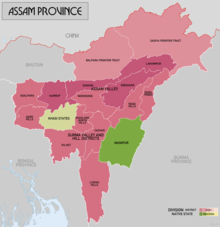| Lushai Hills Autonomous District Council (1947–1954) Mizo Autonomous District Council (1954–1972) Mizoram[1] | |||||||||
|---|---|---|---|---|---|---|---|---|---|
| Autonomous District Council of undivided Assam | |||||||||
| 1947–1972 | |||||||||
 | |||||||||
| Capital | Aizawl | ||||||||
| Population | |||||||||
• 1951 | 196,202[2] | ||||||||
• 1971 | 332,339[3] | ||||||||
| Government | |||||||||
| Deputy Comissioner | |||||||||
• 1952–1953 (first)[4] | Shri. S.N. Barkataki | ||||||||
• 1972 (last)[5] | Shri. G.C. Srivastava | ||||||||
| Historical era | Cold War | ||||||||
| 15 August 1947 | |||||||||
• Abolished chieftainship (Lushai Hills Reorganisation of Chiefs’ Rights Act, 1954)[6] | 1954 | ||||||||
• Renamed as Mizo District (The Lushai Hills District (Change of Name) Act, 1954)[7] | 1954 | ||||||||
• Mautam famine | 1959 | ||||||||
| 28 February 1966 | |||||||||
• Granted UT status | 15 August 1972 | ||||||||
| |||||||||
| Today part of | Mizoram | ||||||||
The Mizo District, also known as the Lushai Hills District, was an autonomous district council of the Indian state of Assam from 1947 till 1972 until it was granted the status of a Union Territory. This region was a significant part of Mizo history as it formally abolished the Mizo chieftainship system in 1952.
The first Mizo chief to give up his chiefdom and chieftainship was Khawvelthanga of Maubuang (1885–1971).[8]
During the Mautam famine of the 1959, Mizo District experienced severe food shortages, and the impact on the Mizo population was profound. Over a hundred people starved to death.[9] Estimations say that around two million rats were killed and collected by the locals.
The Mizo population were extremely upset with the Assam Government as they predicted about the famine two years earlier, but no response was given. As a result, the Mizo National Famine Front was formed for the Mizo people to gain a more autonomous state.[10] In addition, in 1960, the Assam Government officialised Assamese as the official language of Assam without consideration of the Mizo language. These reasons led to the Mizo National Front uprising.